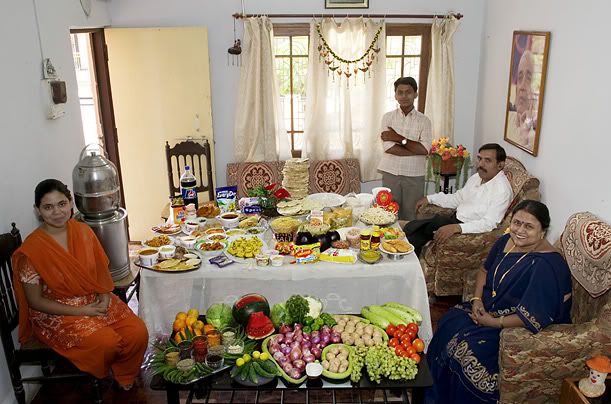By: inoljt, http://mypolitikal.com/
I recently had the pleasure of listening to a fascinating presentation in my Introduction to International Relations class. The professor showed the class pictures what one family in a variety of different countries ate during the duration of a week. The pictures came from the book Hungry Planet, by Peter Menzel. Time Magazine published a series of excerpts (part one and part two) of these pictures.
It was quite interesting to see the typical weekly meal of one family in several countries, ranging from Japan to Germany. The American photo, unfortunately, was the picture-perfect stereotype of over-consuming pre-prepared food (rather than real food).
There was something else that caught my eye, however, as the presentation went on.
More below.
Like many people, I looked forward to seeing the typical weekly meal of a family in China and a family in India.
Here is India:
This is, needless to say, not a typical family in India. In one of the most crowded countries in the world, this Indian family is the proud owner of an entire house. It looks to be a very nice and well-maintained house as well.
Just by looking at the photo, it’s pretty clear that this Indian family is far and above better off than most Indian families. It’s not very representative of India.
Here’s China:
Again, there’s a big surprise here. This Chinese family has somehow managed the trick of having two children. The family also appears to live in a pristine apartment which is definitely not working-class.
It probably requires a lot of money or connections to have more than one child in China. That means that the family pictured here, just like the Indian family pictured, is very unrepresentative of the typical Chinese family. Both families are much wealthier than the typical citizens of their countries.
What’s the point of this?
Well, here’s a picture of a family in Chad:
This is the stereotypical “starving” African family. The food is obviously not enough for the six people in the picture.
There are two pictures of sub-Saharan African families in the entire photo set – and the other photo also fits the stereotype to a tee.
But this family is very definitely not a typical family in Chad. The family here is living in a refugee camp for Darfur refugees, called the Breidjing Camp. Most Chadians do not live in refugee camps. The family pictured here is probably in the poorest ten percent of Chad’s society. It’s not very representative of Chad.
What you may not know is that Africa’s GDP per capita is actually higher than India’s GDP per capita. There’s an argument to be made that Africans actually live better than Indians.
Yet the African family pictured is chronically short of food, while the Indian family (with their comfortable house) obviously belongs to the country’s elite. So does the Chinese family with its multiple kids.
The Point
China, India, and Africa are not nice places. There are hundreds of millions of very very poor people in all three areas.
Yet, as this picture-album perfectly shows, the portrayals of these three civilizations couldn’t be more different. The media always shows India and China as making great progress. China and India are on the path to the good life. Thus the elite families portrayed in this album.
Africa, on the other hand, is perpetually portrayed as an impoverished wasteland. Dictators, starvation, war – it’s hell. Supposedly. The impoverished Chadian and Malian families in Peter Menzel’s pictures are great examples of this theme.
What would the world be like if the media showed impoverished Indian and Chinese peasants all the time? What would the world be like if the media showed rich and wealthy Africans, rather than starving war refugees, all the time? It’s certainly possible to do. There are more than a billion poor peasants to pick in China and India. Africa has plenty of rich people. But somehow I feel that this won’t happen anytime soon.



3 comments